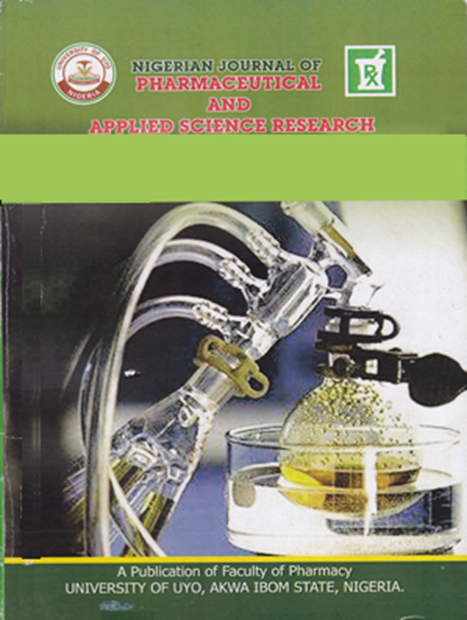Pharmacognostic Studies of Petiveria alliaceae L. (Phytolaccaceae)
Main Article Content
Abstract
Background: Petiveria alliacea, a member of the Phytolaccaceae family, is known for its garlic-like odor and medicinal properties, including anti-inflammatory, antimicrobial, immunomodulatory, anticancer, and analgesic activities. This study aimed to establish quality control parameters for the leaves of P. alliacea.
Methods: Standard procedures were used for microscopy, micrometry, chemomicroscopy, moisture content, ash values, extractive values, fluorescence, and phytochemical analyses.
Results: The leaf exhibited amphistomatic stomatal distribution with anisocytic and anomocytic types. Stomatal indices were 16.5% (abaxial) and 2.9% (adaxial). Micromeritic analysis showed good flow properties, with a bulk density of 0.25±0.006 and an angle of repose of 30.60°. Chemomicroscopy identified mucilage, lignin, starch, oil, and cellulose, while fluorescence analysis revealed solvent-dependent color variations. Extractive values for water, methanol, and ethanol were 12.7%w/w, 8.3%w/w, and 8.0%w/w, respectively. Moisture content was 18.3%w/w. Ash values (total, acid-insoluble, and water-soluble) were 17.4%w/w, 1.33%w/w, and 5.33%w/w, respectively. GC-MS analysis identified nine phytochemicals, with prominent components including Eicosane, 10-butyl-10-propyl- (23.596%), Isophytol (13.509%), Pentyn-4-one (12.253%) and Hexadecanoic acid (10.178%), known for pharmacological activity.
Conclusion: These findings support the identification and authentication of P. alliacea, establishing standards for quality, purity, safety, and efficacy in phytomedicine.
Downloads
Article Details

This work is licensed under a Creative Commons Attribution-NonCommercial-NoDerivatives 4.0 International License.
References
Adesanya EO, Oyesiku OO, Adesanya OO, Ogunlakin, AD, Odugbemi AI and Egieyeh S. (2023). Phytochemical components and GC–MS analysis of Petiveria alliacea L. fractions and volatile oils. Physical Sciences Reviews, 2003: 6(9):1-13.
Del Carmen Cruz-Salomón K, Cruz-Rodríguez RI, Espinosa-Juárez JV, Cruz-Salomón A, Briones-Aranda A, Ruíz-Lau N, Ruíz-Valdiviezo VM. In Vivo and Silico Study of the Antinociceptive and Toxicological Effect of the Extracts of Petiveria alliacea L. Leaves. Pharmaceuticals, 2022: 15(8), 943
Araujo DL, Pinheiro AM, Silver ML, Monteiro C, Prediger RD, Maia CSF, Fontes-Junior EA. Ethnobotany, phytochemistry and neuropharmacological effects of Petiveria alliacea L.(Phytolaccaceae): A review Journal of Ethnopharmacology, 2016: 185: 182-201.
Martha-Estrelle G, Alfredo A, Onel FL, Alexander B, Zoe L. Toxicological Evaluation of an aqueous suspension of leaves and stem of Petiveria alliacea. L (Phytolaccaceae). Journal of Ethnopharmacology, volume 2018: 211: 29-37.
Angiosperm Phylogeny Group “An update of the Angiosperm Phylogeny Group classification for the orders and families of flowering plants: APG IV” Botanical Journal of the Linnean Society, 2016: 18(1): 1-20
Johnny II, Umoh UF, Umoh RA, Alozie MF, Udobre AS, Igboasoiyi AC, Bassey ME, Andy NA, Udo IJ, Umoh OT. Pharmacognostic Characterization of Cola millenii K. Schum. (Malvaceae). Asian Journal of Biology, 2022: 14(1): 6-24.
Metcalfe CR, and Chalk L. Anatomy of the Dicotyledons. Clarendon Press, Oxford, 1979: 1(2):279.
African pharmacopoeia. General method of analysis of pharmacopoeia, 1986: 11: 121-208.
Mbah CC, Builders PF, Akuodor GC, Kunle OO. Pharmaceutical characterization of Bridelia ferniginea Benth. (Euphorbiaceae). Tropical journal of pharmaceutical research, 2012: 11(4):637-644.
Kokate CK, Purohit AP, Gokhale SB. Pharmacognosy. Nairali Prakashan, 4th edition. 2003: 109 (119): 121 -123.
Kokoski CJ, Kokoski RJ, Slama FJ. Fluorescence of powdered vegetable drugs with particular reference to the development of ultraviolet light radiation.Journal of the American Pharmaceutical Association, 1958: 38: 715-719.
Kumar, D., Gupta, J., Kumar, S., Arya, R., Kumar, T. and Gupta, G. Pharmacognostic evaluation of Cayratia trifolia (Linn.) leaf. Asian Pacific Journal of Tropical Biomedicine. 2012: 2(1):6-10.
Umoh RA, Umoh UF, Johnny II, Umoh OT, Anah VU, Udoh AE, Elijah AA, Adefabi M. A, Matthew EA. Phytopharmacognostic Evaluation of the Leaves of Gnetum africanum Welw (Gnetaceae). Journal of Complementary and Alternative Medical Research, 2022: 11(3):32-41.
Sandoval Ortega MH, siqueiros-delgado ME. Tthe families Aizoaceae, Molluginaceae and Phytolaccaceae (Caryophyllales) in the State of Aguascalientes, Mexico. Polibotánica, 2(46): 44-49.
Umoh RA, Johnny II, Umoh OT, Udoh AE, Anah VU, Obah-Eni LC. Pharmacognostic Evaluation of the Leaves and Stems of Justicia secunda Vahl. (Acanthaceae). World Journal of Pharmaceutical Research, 2020: 9(11):5-18.
Umoh RA, Johnny II, Udoh AE, Andy NA, Essien A, Udoh IJ, Ekpo TE, Ashibeshi GU. Taxonomic and Pharmacognostic Evaluation of Leaf of Mussaenda phillippica (Rubiaceae). Asian Plant Research Journal, 2022: 9(1): 6-13.
European Pharmacopoeia. Pharmacopoeial Limits of Crude Drugs. Strasbourg: Council of Europe, 2007: 6:124-164.
McGinty D, Letizia CS, Api AM. Journal of Food and Chemical Toxicology 2010: 48: 76- 81.
Lopes-Martins RAB, Pegorato DH, Woisky R, Penna, SC, Sertie JAA. Anti-inflammatory and analgesic effects of crude extract of Petriveria alliacea L. (Phytolaccaceae). National Library of Medicine, 2002: 9(3): 245 – 248.
. Aparna V, Deleep KV, Mandal PK, Karthe P, Sadasivan C, Haridas M. Anti-inflammatory property of n-hexadecanoic acid: Structural Evidence and Kinetic assessment. National Library of Medicines, 2012: 80(3): 434 – 439.


